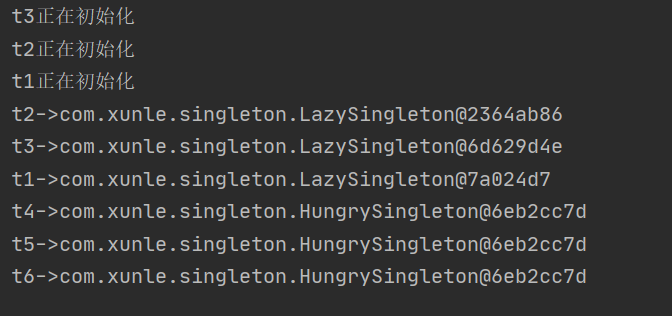单例模式
单例(Singleton)模式:指一个类只有一个实例,且该类能自行创建这个实例的一种模式。
单例模式有 3 个特点:
- 单例类只有一个实例对象;
- 该单例对象必须由单例类自行创建;
- 单例类对外提供一个访问该单例的全局访问点。
对于Java来说,通过将构造方法私有化使外部无法调用构造方法生成多个实例,提供一个静态函数供外部访问单例。单例模式可以保证在一个 JVM 中只存在单一实例。
单例模式通常有两种实现方式
饿汉式单例
类一旦加载就创建一个实例,保证在调用getInstance()方法前已经创建实例
参考代码
1
2
3
4
5
6
7
8
9
| public class HungrySingleton {
private static final HungrySingleton instance = new HungrySingleton();
private HungrySingleton() {}
public static HungrySingleton getInstance() {
return instance;
}
}
|
懒汉式单例
加载时没有生成实例,只有第一次调用时才创建实例。
参考代码
1
2
3
4
5
6
7
8
9
10
11
12
| public class LazySingleton {
private static LazySingleton instance = null;
private LazySingleton() {}
public static LazySingleton getInstance() {
if (instance == null) {
instance = new LazySingleton();
}
return instance;
}
}
|
懒汉式对于实例化类呈懒惰态度,即实例化的时机在第一被引用时触发,在类进行加载时,不会将自己实例化(延迟加载技术)。
懒汉式单例的并发问题
上述懒汉式单例代码存在并发问题,如果多个线程同时访问LazySingleton.getInstance()可能导致类被实例化多次。而饿汉式调用getInstance()前就已经创建实例,不存在并发问题。
并发测试:三个线程调用LazySingleton.getInstance()方法,三个线程调用HungrySingleton.getInstance()方法
1
2
3
4
5
6
7
8
9
10
11
12
13
14
15
16
17
18
19
20
21
22
23
24
25
26
27
28
29
30
31
32
33
34
35
36
37
38
39
40
41
| public class TestSingleton {
public static void main(String[] args) {
Thread t1 = new Thread(() -> {
LazySingleton instance = LazySingleton.getInstance();
System.out.println(Thread.currentThread().getName() + "->" + instance);
}, "t1");
Thread t2 = new Thread(() -> {
LazySingleton instance = LazySingleton.getInstance();
System.out.println(Thread.currentThread().getName() + "->" + instance);
}, "t2");
Thread t3 = new Thread(() -> {
LazySingleton instance = LazySingleton.getInstance();
System.out.println(Thread.currentThread().getName() + "->" + instance);
}, "t3");
t1.start();
t2.start();
t3.start();
Thread t4 = new Thread(() -> {
HungrySingleton instance = HungrySingleton.getInstance();
System.out.println(Thread.currentThread().getName() + "->" + instance);
}, "t4");
Thread t5 = new Thread(() -> {
HungrySingleton instance = HungrySingleton.getInstance();
System.out.println(Thread.currentThread().getName() + "->" + instance);
}, "t5");
Thread t6 = new Thread(() -> {
HungrySingleton instance = HungrySingleton.getInstance();
System.out.println(Thread.currentThread().getName() + "->" + instance);
}, "t6");
t4.start();
t5.start();
t6.start();
}
}
|
测试结果:

懒汉式获取单例时产生了多个实例,饿汉式获取单例时没有影响。
解决线程安全问题
对方法加锁
对getInstance()方法加锁使同一时间只有一个线程获得单例
1
2
3
4
5
6
7
8
9
10
11
12
| public class ThreadSafeSingleton {
private static volatile ThreadSafeSingleton instance;
private ThreadSafeSingleton() {}
public static synchronized ThreadSafeSingleton getInstance() {
if (instance == null) {
instance = new ThreadSafeSingleton();
}
return instance;
}
}
|
这样可以保证只会创建一个实例,volatile防止指令重排序,但synchronized锁住了整个方法,多线程访问时性能会降低。
双重检查锁
1
2
3
4
5
6
7
8
9
10
11
12
13
14
15
16
17
| public class DoubleCheckSingleton {
private static volatile DoubleCheckSingleton instance;
private DoubleCheckSingleton() {}
public static DoubleCheckSingleton getInstance() {
if (instance == null) {
synchronized (DoubleCheckSingleton.class) {
if (instance == null) {
System.out.println(Thread.currentThread().getName()+ "正在初始化");
instance = new DoubleCheckSingleton();
}
}
}
return instance;
}
}
|
如果多个线程进入getInstance()方法
- 先判断是否已存在实例,若已存在则直接返回,否则获得锁创建实例
- 线程获得锁后先判断是否已存在实例。原因是如果线程A和线程B同时竞争锁,线程A获得锁进入并创建实例后释放锁,此时线程B获得锁且并不知道实例已被创建的话,会继续创建新实例,所以需要第二次判断。
内部类
枚举
